Friday’s Faces from the Past: Curmudgeon Day
Benjamin Family, McMurray Family, Lee Family, Helbling Family (Click for Family Tree)
W. C. Fields (above) was a curmudgeon, and on the anniversary of his birth on 29 February 1880, we celebrate all the curmudgeons we know and love- or try to love.
What is a curmudgeon, you may ask? Generally described as a complaining, crotchety, critical old man, in the interest of equal rights we will include women as possibilities too. “Snarling contempt” is a good phrase that can describe the opinions, attitudes, and writings of curmudgeons. The very best curmudgeons, however, will add a bit of humor or dry wit to their scathing words, and give us an insight into the human condition; sometimes they even make a career out of it.
W. C. Fields is famous for many a curmudgeonly phrase, some from his movies, and some said on his own while in character (he was said to personally be a kind man). Many other quotes have been attributed to him but may not be really his words. Here are a few of his most famous:
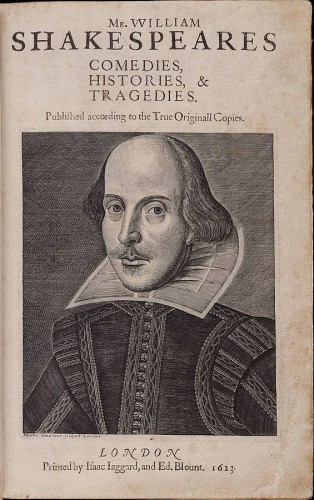
The characters of William Shakespeare issued their share of curmudgeonly insults to each other long before- and now after- W. C. Fields:
“There’s no more faith in thee than in a stewed prune.” (from Henry V)
“Thine face is not worth sunburning.” (from Henry V)
“Your brain is as dry as the remainder biscuit after voyage.” (from As You Like It)
“You are as a candle, the better burnt out.” (from Henry IV, Part 1)
Nowadays, we may have to extend the definition of ‘curmudgeon’ to include cartoons (Lucy always complaining and nagging Charlie Brown), puppets (Oscar the Grouch), and even internet memes (Grumpy Cat). And when you put two together you get…
Isn’t the internet wonderful??
We all know some curmudgeons, and likely have a few in the family, though it is doubtful that any of our dear readers would fit into that category. We won’t name (many) names, but we do have a few ancestors who are long gone that we could possibly honor as Curmudgeons on this very special day.
OK, OK, it’s not really that special a day, as any true curmudgeon would proclaim.

Samuel J. Lee (1879-1964) ran a drugstore in St. Louis, Missouri. As the neighborhood changed and got quite a bit rougher, it is understandable that he might have turned a bit curmudgeonly. Only apparently Sam sort of was that way even before. A nephew who worked for him said that it did not take much to get Sam upset. He actually had a peephole in the wall of the drugstore- something common to many stores so that an owner could truly ‘keep an eye’ on things. The nephew stated, however, that Sam would monitor his work performance through the peephole, to make sure he did not dish out too much ice cream to a customer at the soda fountain, or even worse, sample the ice cream himself.
Sam was a quiet man, according to another family member. He didn’t talk much, and in the evenings would just go sit in the sunroom of the house on Alamo, read his paper and smoke a cigar. So maybe he was more a quiet man, and people just took that silence as curmudgeonly?
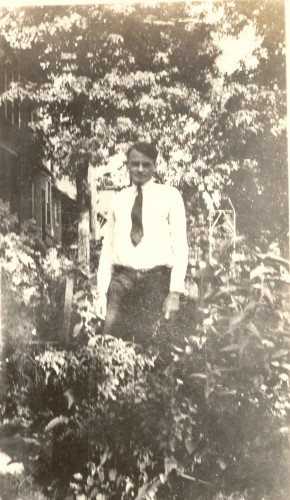
Gerard William “G. W.” Helbling (1882-1971) did not have the benefit of much formal education, but he was a brilliant man. That brilliance could drive some people crazy, though, like one of his daughters. She said he always had a criticism for a movie, an article, or whatever. He would explain how it could not really happen, why it wasn’t true, the facts that were missing, or how it was biased. He was most likely right, as he was a prodigious reader and knowledgeable about a whole lot of things. He would often guess what would happen next, and spoil the plot line.
He could be a very loving man, however, and the love he showed for his dear wife, Anna May (Beerbower) Helbling, was the kind of love women (ok, men too) dream about.
So maybe we can’t officially call him a curmudgeon? Maybe just a part-time curmudgeon, who was usually right.
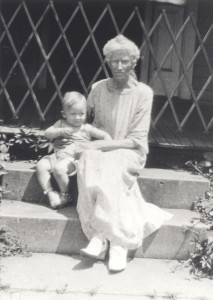
We don’t really know enough about Hannah Melissa “Malissa” (Benjamin) McMurray (1854-1932) to officially proclaim her a curmudgeon. We don’t know that she was a complainer- her life was filled with work on the farm until her mid-fifties, and raising five children. She must have been a special woman to have endured it all, and some complaints, if any, should be excused.
But asking a descendant to identify the above picture was interesting. There was no name, and the informant was the young great-grandson pictured with Hannah Melissa (Benjamin) McMurray above. At first he did not recognize her through the fading lenses and memories of the 70+ years that had passed since that picture was taken. Then he looked up, in a somewhat taken aback fashion, when asked if it could be Hannah Melissa (Benjamin) McMurray. (Possibilities had been narrowed time-wise.) “Yes,” he replied. “She was VERY stern.” He was one who always gave people the benefit of the doubt, but apparently she curbed the enthusiasm of a toddler quite significantly, and he remembered it deeply when asked so many years later. He wouldn’t elaborate on whether that sternness was due to her complaining or just silently expecting him to toe the line; so maybe she was a pseudo-curmudgeon.
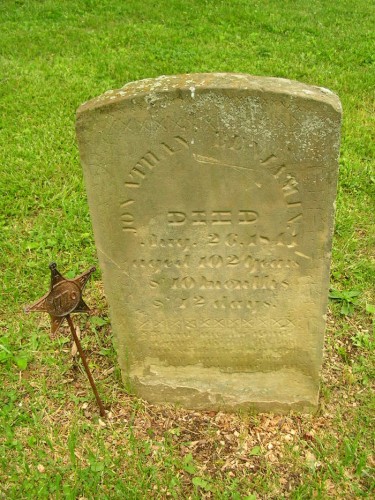
Jonathan Benjamin (1739-1841) was the third-great grandfather of Malissa (Benjamin) McMurray. Maybe Malissa got some of his ‘stern’ DNA.
The 1881 tome (816 pages!) compiled by N. N. Hill, Jr. called “History of Licking County, O., Its Past and Present: Containing a Condensed, Comprehensive History of Ohio, Including an Outline History of the Northwest, a Complete History of Licking County … a History of Its Soldiers in the Late War … Biographies and Histories of Pioneer Families, [and it goes on…]” tells Jonathan’s story the best:
http://warehouse13.wikia.com/wiki/File:W-C-Fields.jpg. CC-BY-SA license.
Please contact us if you would like higher resolution images. Click to enlarge images.
http://heritageramblings.net/2014/10/05/sundays-obituary-samuel-j-lee/
http://heritageramblings.net/2013/12/13/five-family-photos-for-friday-samuel-j-lee-of-st-louis-missouri/
http://heritageramblings.net/2013/12/19/those-places-thursday-samuel-j-lee-and-son-pharmacy-st-louis-missouri/
http://heritageramblings.net/2014/10/02/those-places-thursday-aiken-family-homes/
http://heritageramblings.net/2014/07/02/wordless-wednesday-lee-family-clock/Original content copyright 2013-2015 by Heritage Ramblings Blog and pmm.
Family history is meant to be shared, but the original content of this site may NOT be used for any commercial purposes unless explicit written permission is received from both the blog owner and author. Blogs or websites with ads and/or any income-generating components are included under “commercial purposes,” as are the large genealogy database websites. Sites that republish original HeritageRamblings.net content as their own are in violation of copyright as well, and use of full content is not permitted.
Descendants and researchers MAY download images and posts to share with their families, and use the information on their family trees or in family history books with a small number of reprints. Please make sure to credit and cite the information properly.
Please contact us if you have any questions about copyright of our blog material.
Labor Day: Celebrating the Labors of Our Ancestors
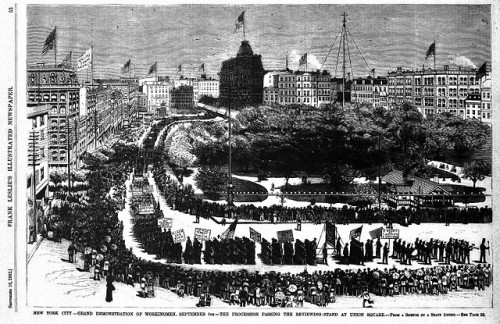
Labor Day officially became a federal holiday in the United States in 1894. “The Gilded Age” included the rise of big business, like the railroads and oil companies, but laborers fought- sometimes literally- for their rights in the workplace. Grover Cleveland signed the law to honor the work and contributions, both economic and for society, of the American laborer. Celebrated on the first Monday in September, ironically the holiday was a concession to appease the American worker after the government tried to break up a railroad strike but failed.
The Labor Day weekend is a good time to think about our ancestors and the work they did to help move our country and their own family forward.
Jefferson Springsteen was a mail carrier through the wilds of early Indiana, traveling for miles on horseback through spring freshets (full or flooding streams from snow melt), forest, and Indian villages. Samuel T. Beerbower, who would be a some-number-great uncle depending on your generation, was the Postmaster in Marion, Ohio, for many years. “Neither snow nor rain nor heat nor gloom of night stays these couriers from the swift completion of their appointed rounds.”

Bad weather, gloom of night, ocean crossings in the mid 1800s, and the threat of disease or injury did not stay our minister, deacon, and missionary ancestors from their appointed rounds either- especially since the felt they were appointed by a higher power. We have quite a number of very spiritual men in the family. Henry Horn became a Methodist circuit rider after coming to America as a Hessian soldier, being captured by George Washington’s troops in Trenton, NJ, then taking an Oath of Allegiance to the United States, and serving in the Revolutionary Army. The family migrated from Virginia to the wilds of western Pennsylvania sometime between 1782 and 1786. A story is told of how he was riding home from a church meeting in the snow. The drifts piled up to the body of the horse, and they could barely proceed on, but Henry did, and was able to preach another day. He founded a church Pleasantville, Bedford Co., Pennsylvania that still stands, and has a congregation, even today. Edward B. Payne and his father, Joseph H. Payne, Kingsley A. Burnell and his brother Thomas Scott Burnell were all ministers, some with formal schooling, some without. Edward B. Payne gave up a lucrative pastorate because he thought the church members were wealthy and educated enough that they did not need him. He moved to a poor church in an industrial town, where he was needed much more, however, he may have acquired his tuberculosis there. He also risked his life, and that of his family, by sheltering a woman from the domestic violence of her husband, and he testified on her behalf.
Abraham Green was one of the best tailors in St. Louis, Missouri in the early 1900s, and many in the Broida family, such as John Broida and his son Phillip Broida, plus Phillip’s daughter Gertrude Broida Cooper, worked in the fine clothing industry.
Edgar Springsteen worked for the railroad, and was often gone from the family. Eleazer John “E.J.” Beerbower worked for the railroads making upholstered cars- he had been a buggy finisher previously, both highly skilled jobs.
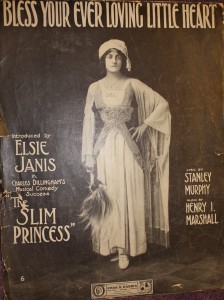
The theater called a number of our collateral kin (not direct lines, but siblings to one of our ancestors): Max Broida was in vaudeville, and known in films as “Buster Brodie.” Elsie Janis, born Elsie Beerbower, was a comedienne, singer, child star in vaudeville, “Sweetheart of the A.E.F” as she entertained the troops overseas in World War I, and then she went on to write for films. Max Broida also did a stint in the circus, as did Jefferson Springsteen, who ran away from home as “a very small boy” to join the circus (per his obituary).
Collateral Lee family from Irthlingborough, England, included shoemakers, as that was the specialty of the town. They brought those skills to Illinois, and some of those tools have been handed down in the family- strange, unknown tools in an inherited tool chest turned out to be over 100 years old!
Will McMurray and his wife Lynette Payne McMurray owned a grocery store in Newton, Iowa. Ella V. Daniels Roberts sold eggs from her chickens, the butter she made from the cows she milked, and her delicious pies at the McMurray store. Franz Xavier Helbling and some of his brothers and sons were butchers in Lawrenceville, Pennsylvania, near Pittsburgh, and had their own stores.
Some of our ancestors kept hotels or taverns. Joseph Parsons (a Burnell ancestor) was issued a license to operate an ‘ordinary’ or “house of entertainment” in 1661 in Massachusetts, and Samuel Lenton Lee was listed as “Keeps hotel” and later as a saloon keeper in US Federal censuses. Jefferson Springsteen had a restaurant at the famous Fulton Market in Brooklyn, NY in the late 1840s.
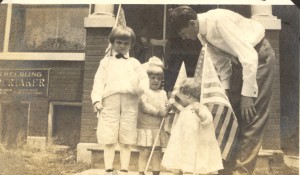
Many of our family had multiple jobs. William Gerard Helbling (AKA Gerard William Helbling or “G.W.”) listed himself as working for a theater company, was an artist, then an undertaker, and finally a sign painter. George H. Alexander was artistic as well- he created paintings but also worked as a lighting designer to pay the bills.
Sometimes health problems forced a job change. Edward B. Payne was a Union soldier, librarian, and then a pastor until he was about 44 when his respiratory problems from tuberculosis forced him to resign the pulpit. For the rest of his life he did a little preaching, lecturing, and writing. He also became an editor for a number of publications including, “The Overland Monthly,” where he handed money over from his own pocket (per family story) to pay the young writer Jack London for his first published story. Edward B. Payne even founded a Utopian colony called Altruria in California! He and his second wife, Ninetta Wiley Eames Payne, later owned and conducted adult ‘summer camps’ that were intellectual as well as healthy physically while camping in the wild and wonderful northern California outdoors.
Other times, health problems- those of other people- are what gave our ancestors jobs: Edward A. McMurray and his brother Herbert C. McMurray were both physicians, as was John H. O’Brien (a Helbling ancestor), who graduated from medical school in Dublin, Ireland, and came to America in 1832. He settled in western Pennsylvania, still wild and in the midst of a cholera epidemic that was also sweeping the nation; he had his work cut out for him. (It appears he did not get the same respect as other doctors because he was Irish, and this was pre-potato famine.) Lloyd Eugene “Gene” Lee and his father Samuel J. Lee owned a drugstore in St. Louis, as did Gene’s brother-in-law, Claude Aiken. Edith Roberts McMurray Luck worked as a nurse since she received a degree in biology in 1923.
We have had many soldiers who have helped protect our freedom, and we will honor some of those persons on Veterans Day.
We cannot forget the farmers, but they are too numerous to name them all! Even an urban family often had a large garden to supplement purchased groceries, but those who farmed on a larger scale included George Anthony Roberts, Robert Woodson Daniel, David Huston Hemphill, Amos Thomas, etc., etc. We even have a pecan farmer in the Lee family- William Hanford Aiken, in Waltham County, Mississippi, in the 1930s-40s.
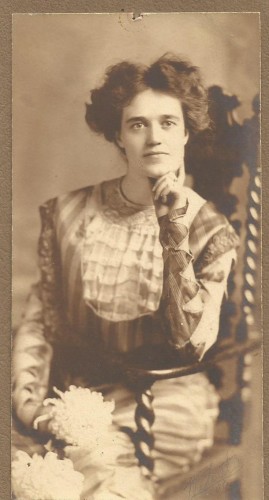
We must also, “Remember the ladies” as Abigail Adams entreated her husband John Adams as he helped form our new nation. He/they did not, so 51% of the population-women- were not considered citizens except through their fathers or husbands. Many of these women, such as Lynette Payne McMurray, labored to get women the right to vote, equal pay, etc. (Lynette ‘walked the talk’ too- she was the first woman to ride a bicycle in Newton, Iowa! Not so easy when one thinks about the clothing involved.) Some men, like her father, Edward B. Payne, put their energy into the women’s suffrage movement as well. Many of our ancestors worked for the abolition movement too, including the Payne and Burnell families.
A woman worked beside her husband in many families, although she would get little credit for it. Who cooked the meals and cleaned the rooms for the Lee and Parsons innkeepers? Likely their wives, who also had to keep their own home clean, laundry washed, manage a garden and often livestock- many families kept chickens even if they didn’t have a farm. They raised and educated their many children too, sometimes 13 or more. Oh yes, let’s not forget that women truly ‘labored’ to bring all those children into the world that they had made from scratch. (Building a human from just two cells makes building a barn seem somewhat less impressive, doesn’t it?) Some of them even died from that labor.
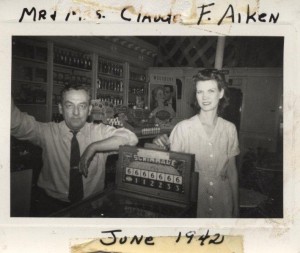
Working alongside one’s husband could be frightening due to the dangers of the job. A noise in the Aiken family drugstore in St. Louis, Missouri in 1936 awoke Claude and Mildred Aiken since they lived in the back of the store. Claude look a gun and went into the store while Mildred called the police. Claude fired the gun high to frighten the intruder- Mildred must have been very scared if she was in the back, wondering who had fired the shot and if her husband was still alive. Thankfully he was, and the police were able to arrest the thief, who wanted to steal money to pay a lawyer to defend him in his three previous arrests for armed burglary and assault.
We applaud all of our ancestors who worked hard to support their family. Their work helped to make the US the largest economic power in the world, and a place immigrants would come to achieve their ‘American dream.’ We hope our generation, and the next, can labor to keep our country prosperous and strong.
Notes, Sources, and References:
- There are too many folks listed here to add references, but using the search box on the blog page can get you to any of the stories that have been posted about many of these persons. Of course, there is always more to come, so stay tuned!
Please contact us if you would like higher resolution images. Click to enlarge images.
We would love to read your thoughts and comments about this post (see form below), and thank you for your time! All comments are moderated, however, due to the high intelligence and persistence of spammers/hackers who really should be putting their smarts to use for the public good instead of spamming our little blog.Original content copyright 2013-2015 by Heritage Ramblings Blog and pmm.
Family history is meant to be shared, but the original content of this site may NOT be used for any commercial purposes unless explicit written permission is received from both the blog owner and author. Blogs or websites with ads and/or any income-generating components are included under “commercial purposes,” as are the large genealogy database websites. Sites that republish original HeritageRamblings.net content as their own are in violation of copyright as well, and use of full content is not permitted. Descendants and researchers MAY download images and posts to share with their families, and use the information on their family trees or in family history books with a small number of reprints. Please make sure to credit and cite the information properly. Please contact us if you have any questions about copyright of our blog material.Workday Wednesday continued on Thursday: Tilling the Soil, Part 2
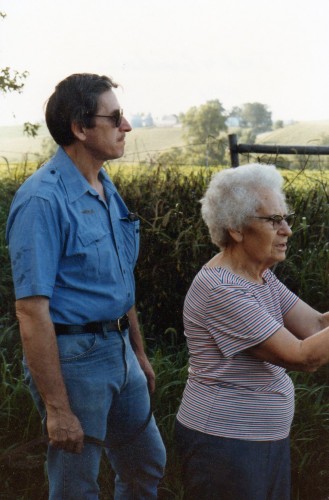
Here are just a few of our farming and gardening ancestors that I was thinking of as I worked with the soil and plants on the land we own, and that we can pass on to our descendants, just like our ancestors did:
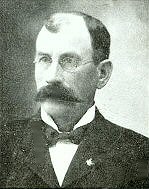
Frederick Asbury “F.A.” McMurray (1850-1929) worked on the family farm as a child, with his occupation listed as “works on farm” on the 1870 US Federal Census when he was 19; he was living in the household of his parents, Henderson McMurray and Mary Ann Horn McMurray. Of their 11 children, the boys apparently stayed in school until 14 or 15, though they probably took time off – or school was closed- for planting and harvest. The four oldest boys worked on the farm full-time, and the family boarded a 20 yr old woman who also helped with the housework- a lot of hungry mouths to feed after that hard farm labor, and a lot of dirty laundry.
F. A. married and in 1880 was listed as a farmer in the census. He became an auctioneer about 1880; he cried over 128 sales in 1902 (‘cried’ is a term for what an auctioneer does as he offers lots for sale), with the very large average of $2,100 per sale making him an auctioneer in demand- he was very good at getting the prices up for his sellers. (Since he probably took a percentage of the sales, there was good incentive to describe the goods in an enticing way, then encourage more bidders to make a higher offer.) By the 1885 Iowa State Census F. A. was listed as having a Second Hand Store- a good spin-off for an auctioneer, and a lot less physical work than being a farmer. (McMurray Family Ancestor– click for family tree)
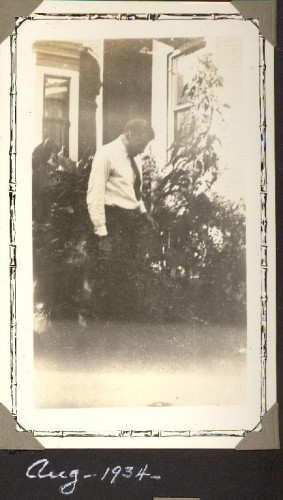
Gerard William Helbling loved roses, and had a flower garden he loved. (He never seemed the sort…) He grew some veggies, such as tomatoes, too. (Helbling Family Ancestor– click for family tree.)
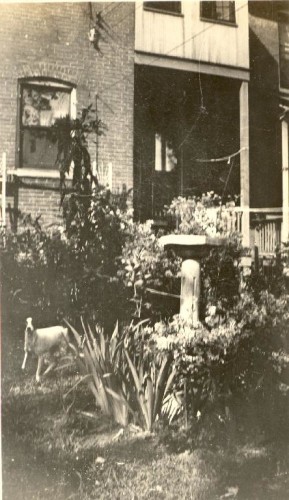
William “Bill” Aiken supposedly had a pecan farm in Tylertown, Walthall County, Mississippi in the 1930s. (Lee Family Ancestor– click for family tree.)
Samuel T. Beerbower showed livestock at the county fair, so likely grew some of his own hay for grazing. (Helbling/Beerbower Family Ancestor– click for family tree.)

Notes, Sources, and References:
1) Frederick A. McMurray, auctioneer article from the Daily Herald, Newton, Iowa, 01 Jan 1903, page 9.
2) Samuel T. Beerbower article as cited above.
3) Family treasure chest of photos.
Please contact us if you would like higher resolution images. Click to enlarge images.
We would love to read your thoughts and comments about this post (see form below), and thank you for your time! All comments are moderated, however, due to the high intelligence and persistence of spammers/hackers who really should be putting their smarts to use for the public good instead of spamming our little blog.Original content copyright 2013-2015 by Heritage Ramblings Blog and pmm.
Family history is meant to be shared, but the original content of this site may NOT be used for any commercial purposes unless explicit written permission is received from both the blog owner and author. Blogs or websites with ads and/or any income-generating components are included under “commercial purposes,” as are the large genealogy database websites. Sites that republish original HeritageRamblings.net content as their own are in violation of copyright as well, and use of full content is not permitted. Descendants and researchers MAY download images and posts to share with their families, and use the information on their family trees or in family history books with a small number of reprints. Please make sure to credit and cite the information properly. Please contact us if you have any questions about copyright of our blog material.World Tuberculosis Day and Our Ancestors

Beerbower Family, Broida Family, Payne Family
Consumption. Phthisis. Scrofula. Pott’s Disease. The White Plague.
These are all names that were used for tuberculosis (TB), the deadliest disease for many centuries- even for thousands of years. Tuberculosis was described and found in ancient Egypt, and Hippocrates wrote that it was the most prevalent cause of death in Greece. TB has even been found in Neolithic bone 9,000 years old! Closer in time, for 200 years in Europe it was “The White Plague” and killed hundreds of thousands, and more than 30% of Europeans died of TB in the 1800s. Some think that in the industrialized cities, 100% of the poverty-stricken working class was infected with TB. It is estimated that at least 40% of deaths in this group were caused by tuberculosis.
Sanitation in the 1800s, or the lack thereof, was thought by some to be the cause. Sanatoriums were hoped to be a cure in the mid- and late-1800s, by getting patients out of the polluted, closely-packed, dirty cities. Fresh air, along with the prescribed good nutrition and exercise, did some good- consumptives (persons with TB, also called “TBs” or “Lungers”) sometimes actually did improve, and some claimed, were cured. In the United States, moving west to the Rockies or California helped many, including some of our ancestors. Unfortunately, a ‘better’ climate did not help all, including some of our ancestors as well.
Tuberculosis (TB) is an airborne bacterial disease, but that fact was not common knowledge until Robert Koch delivered a paper on his discovery of the bacterium on 24 March 1882- hence, ‘World Tuberculosis Day’ today. The use of x-rays in the early 1900s helped with diagnosis of the disease, but until the discovery in the 1940s of antibiotics that could treat TB, there was no hope of a true cure, but only possible remission, which did sometimes occur.
The most common symptom of TB is a cough, often with bloody sputum; night sweats, a general malaise, fever, and exhaustion may also occur. It is a slow disease, eating away from the inside, and sometimes the outside too, even affecting parts of the body other than the lungs.
A century or two ago, some felt that consumptives were more sensitive, artistic, etc.- Elizabeth Barrett Browning, Robert Louis Stevenson, Anton Checkov, Thoreau, the Bronte sisters, Chopin, Stephen Crane, Robert Heinlein, Franz Kafka, D.H. Lawrence, George Orwell, Sarah Bernhardt, Edvard Munch, and many more died of TB. It became fashionable for women to paint their faces almost white to get that pale, delicate complexion seen in consumptives after wasting away for many years.
Tuberculosis is spread when persons carrying the bacterium cough, sneeze, speak, or sing; the bacterium can stay in the air for many hours and infect someone else when that air is breathed in. A carrier may have the bacterium for many years and not know it, but something, such as immune suppression or pregnancy, can trigger the disease into an active state. For some, it may take 15 years or more to waste away with the disease.

Spittoons have a place in this discussion- men spit tobacco everywhere back in the day, and that actually spread TB. Using spittoons helped to corral the infection into those brass vessels instead of all over where it could travel via shoes, long dresses, etc. Wonder if the people who cleaned spittoons had a higher rate of the disease?
Pasteurization of milk also helped decrease the disease in developed countries, as the bovine (cow) form of tuberculosis can be spread to humans. This is a real problem today in India and Africa.
TB is not just a disease of the third world these days- with antibiotic resistance increasing and the number of persons immigrating to western countries carrying Mycobacterium tuberculosis, plus illnesses like HIV and drugs that suppress the immune system (such as some of the new anti-inflamatories), TB is on the rise, even in the US.
Our ancestors would be disappointed to see this trend, as TB would have been something terrible they coped with throughout their lifetime, or with family or friends. They most probably would have thought that it would be curable and then eradicated by the year 2015.
We have had at least 3 ancestors appear unexpectedly out west- two were very puzzling, as the reason for their move was not evident, until one sees the cause of death on the death certificate: tuberculosis. They had gone west in pursuit of golden health, not the gold in the ground.
Robert Warson Beerbower, son of Edgar Peter Beerbower and Anna Missouri Springsteen, was enumerated in the 01 Jun 1900 US Federal Census in Indianapolis, Marion, Indiana, with his wife of just two years, Josephine Reiffel Beerbower. He was working as a railroad clerk, and they were living with his wife’s parents. The couple was expecting their first child. Robert’s job was probably not very strenuous as a clerk, however he was sick. Robert traveled to Denver, Colorado, likely alone, and likely leaving his pregnant wife in Indianapolis. They would have known he had TB, but there were no antibiotics to cure it at that time. He died of tuberculosis on 12 Sep 1900 in Denver, and his body was returned to Indianapolis, Indiana for burial. Robert was only 26 years old. “Rob’s little baby,” Roberta Pearl Beerbower, was born just a month later and named after her father.
Sarah Gitel Frank Broida was born in Lithuania and immigrated to the United States about 1881. She was the mother of nine children, with seven surviving childhood. The family were poor immigrants, living in industrial, polluted Pittsburgh, Pennsylvania, working as ‘rag pickers’ initially. Their son Harold Broida was born 25 Dec 1897, and the 1899 City Directory places the family living at 1102 Fifth Avenue in Pittsburgh. By 07 June 1900, Gitel, her husband John (or Zelig) Broida, oldest son Joseph, and youngest son Harold were living in Denver, Colorado; the other sons were staying with scattered family back east. This was very puzzling- the Broidas were city folk, and it was hard to imagine them in the still somewhat wild west of 1900. Family oral history, however, stated that Gitel had died of tuberculosis, so their move to the sanitariums there or just the more favorable climate and cleaner air made sense, especially since antibiotics to cure TB would not be available for another 40 years. Perhaps one of Gitel’s many pregnancies had triggered the infection possibly picked up years before, maybe from contaminated rags from their early days in the US, or the disease could have been newly acquired. Gitel died in Denver on 14 April 1901 at the age of 41. Her mortuary record verifies that she died of tuberculosis. (Unfortunately the state of Colorado won’t share her 114 year old death certificate- but they took the money paid for it. Apparently a great-grandchild is not closely related enough to view it, despite the certificate previously being online.)
Edward B. Payne had worked in the tenements of Chicago around 1872, and in the mill towns of Massachusetts and New Hampshire with the poor during the 1880s. He had been called to a position in Berkeley, California, between those years, but had returned to visit family and decided to stay in New England. Edward apparently acquired tuberculosis sometime in the 1880s, if not before; it may possibly have worsened by 1890 or so. In 1892 the family chose to go back to California, in hope that it would improve his health, plus provide him more of what he wished for in his professional and spiritual life. (He was a minister.) The climate must have helped, as Edward lived another 31 years, to age 76, without the cure of antibiotics. He did spend a lot of time outdoors as was recommended for those with tuberculosis, and became a convert to some of the ‘newest’ healthy foods, like whole grain breads, so those treatments may have helped him survive the disease.
Other family members, like the Lees and Aikens, traveled frequently to Colorado. We do know that for the Lees it was due to respiratory problems- plus they loved the mountains- but know of no one that definitely had tuberculosis.
Notes, Sources, and References:
1) Tuberculosis References :
http://www.cdc.gov/tb/publications/factsheets/general/tb.htm
http://ocp.hul.harvard.edu/contagion/tuberculosis.html
http://www.merckmanuals.com/home/infections/tuberculosis_and_leprosy/tuberculosis.html
http://en.wikipedia.org/wiki/History_of_tuberculosis
http://en.wikipedia.org/wiki/List_of_tuberculosis_cases
2) Robert Warson Beerbower- see other posts:
http://heritageramblings.net/2015/01/04/beerbower-family-bible-deaths/
(Robert’s death and “Rob’s little baby” entry for Roberta’s birth.)
http://heritageramblings.net/2015/02/12/treasure-chest-thursday-roberta-p-beerbower-wertz/
3) Sarah Gitel Frank Broida- see the following posts:
http://heritageramblings.net/2013/11/25/mystery-monday-gitelgertude-frank-broida/
http://heritageramblings.net/2015/01/29/those-places-thursday-denver-colorado-and-the-broida-family/
http://heritageramblings.net/2015/02/06/friday-follow-up-death-record-of-sarah-gitel-frank-broida/
4) There are no posts yet about this time period in Edward B. Payne’s life- those are in the works.
Please contact us if you would like higher resolution images. Click to enlarge images.
We would love to read your thoughts and comments about this post (see form below), and thank you for your time! All comments are moderated, however, due to the high intelligence and persistence of spammers/hackers who really should be putting their smarts to use for the public good instead of spamming our little blog.Original content copyright 2013-2015 by Heritage Ramblings Blog and pmm.
Family history is meant to be shared, but the original content of this site may NOT be used for any commercial purposes unless explicit written permission is received from both the blog owner and author. Blogs or websites with ads and/or any income-generating components are included under “commercial purposes,” as are the large genealogy database websites. Sites that republish original HeritageRamblings.net content as their own are in violation of copyright as well, and use of full content is not permitted. Descendants and researchers MAY download images and posts to share with their families, and use the information on their family trees or in family history books with a small number of reprints. Please make sure to credit and cite the information properly. Please contact us if you have any questions about copyright of our blog material.All because two people fell in love…

➡ Beerbower Family, Helbling Family, Lee Family, Cooper Family, McMurray Family, Whitener Family
My mother always told me that I was here on earth because two people fell in love, but Brad Paisley’s hit song said it in a slightly more catchy way:
“There ain’t nothin’ not affected
When two hearts get connected…
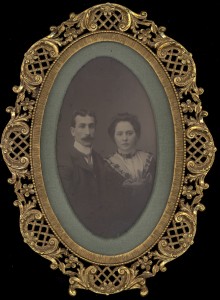
Every one of us is here
All because two people fell in love.”

The Brad Paisley song, “Two people fell in love” is delightfully sweet, whether one is a country fan or not.
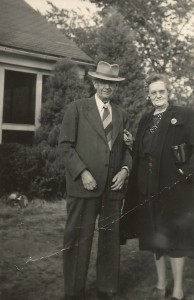
Brad Paisley goes on to sing:
“I’m glad your dad could not resist
Your mama’s charms and you exist
All because two people fell in love.”
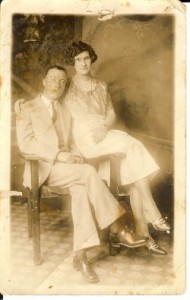
Take a look at the full lyrics here. They are very sweet- as are these pictures of ancestor couples.
Thank you, dear ancestors, for falling in love.
Have a love-ly Valentine’s Day!
Notes, Sources, and References:
1) “Two People fell in Love” by Tim Owens, John Lovelace, Copyright: Emi April Music Inc., Sea Gayle Music, Love Ranch Music- http://www.azlyrics.com/lyrics/bradpaisley/twopeoplefellinlove.html
Portions of the lyrics posted for educational use only.
2) Photos from family treasure chests.
Please contact us if you would like higher resolution images.
We would love to read your thoughts and comments about this post (see form below), and thank you for your time! All comments are moderated, however, due to the high intelligence and persistence of spammers/hackers who really should be putting their smarts to use for the public good instead of spamming our little blog.Copyright 2013-2015 by Heritage Ramblings Blog and pmm.
Family history is meant to be shared, but the original content of this site may NOT be used for any commercial purposes unless explicit written permission is received from both the blog owner and author. Blogs or websites with ads and/or any income-generating components are included under “commercial purposes,” as are the large genealogy database websites. Sites that republish original HeritageRamblings.net content as their own are in violation of copyright as well, and use of full content is not permitted. Descendants and researchers MAY download images and posts to share with their families, and use the information on their family trees or in family history books with a small number of reprints. Please make sure to credit and cite the information properly. Please contact us if you have any questions about copyright of our blog material.SaveSave